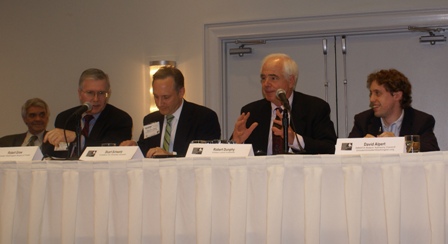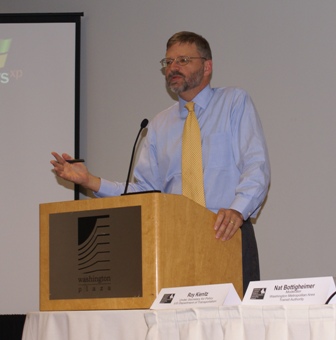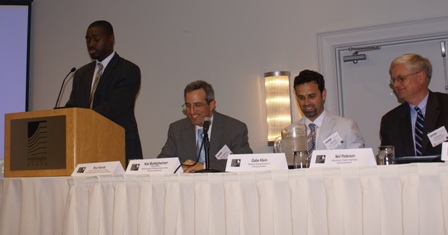Washington, D.C. - After a day-long conference on providing new transportation choices, members of the National Capital Region Transportation Planning Board (TPB), including previous TPB Chairs Phil Mendelson, District of Columbia Councilmember, and Catherine Hudgins, Fairfax County Supervisor, agreed to make priority buses a priority for the region.
The conference, sponsored by the TPB and the Federal Transit Administration (FTA), focused on improving the metropolitan Washington region’s transit system by implementing priority bus transit. There are currently a number of high performance bus projects under development or implementation throughout the region, however funding for many of these projects is uncertain, as state and county budgets have been tightened due to the current economic situation. This conference was held to support the region’s transportation planning efforts by bringing together key stakeholders to learn about options for prioritizing bus transit and building consensus for a regional priority bus network.
Following introductory statements by Charles Jenkins, TPB Chair and Frederick County Commissioner, and Harriet Tregoning, TPB Scenario Study Task Force Chair and Director of the D.C. Office of Planning, a series of presentations and panel discussions were held on various aspects of priority bus transit. Howard Benn, from Montgomery County Ride-On and Chair of the TPB Regional Bus Subcommittee gave an opening presentation on the current status of bus transit and the role of bus transit in the regional transportation system. Benn noted that that “choice” riders (as opposed to the transit-dependent) actually make up a substantial portion of bus ridership in the region.

(from left to right: Panel Moderator Ron Kirby, Director of Transportation Planning at COG; Robert Grow, Greater Washington Board of Trade; Stewart Schwartz, Coalition for Smarter Growth; Robert Dunphy, Urban Land Institute; and David Alpert, GreaterGreaterWashington.org)
The first panel, which consisted of representatives from planning and transit agencies from across the country, highlighted different priority bus strategies currently in place, ranging from the creation of dedicated busways in Cleveland, to Bus on Shoulder (BOS) operations in the Twin Cities region of Minnesota, to smaller changes such as signal prioritization, off-vehicle fare collection, and near-level boarding.
A second panel featured several representatives from local and national stakeholder groups. Robert Dunphy from the Urban Land Institute noted the importance of changing negative perceptions of buses by better educating the public. David Alpert, the founder of the urban affairs blog, GreaterGreaterWashington.org, and member of the Washington Metropolitan Area Transit Authority (WMATA) Riders’ Advisory Council said that any priority bus network should focus on making substantial improvements to a few primary corridors at a time rather than trying to make small changes system-wide.

Keynote speaker Roy Kienitz, Under Secretary of Transportation for Policy, U.S. Department of Transportation
The keynote address was delivered by Roy Kienitz, Under Secretary of Transportation for Policy at the U.S. Department of Transportation (DOT). One of the main topics that Kienitz discussed was the opportunities present in the American Recovery and Reinvestment Act (ARRA) for the metropolitan Washington region.
In addition to spurring discussion on the topic, one of the primary reasons for the conference was the immediate opportunity for ARRA funding. The ARRA will provide the region with hundreds of millions of dollars in formula funding. The ARRA has also reserved $1.5 billion in funding to be distributed via a new multimodal discretionary funding program known as TIGER (Transportation Improvements Generating Economic Recovery). The members and staff of the TPB’s Scenario Study Task Force are developing a plan for the first phase of a regional priority bus network, with the intention of seeking funding for this plan through the TIGER program.
Tregoning asked Kientiz to discuss what he would be looking for when determining which submissions will receive funding. Noting that DOT has little experience in discretionary funding, Kienitz asked the TPB to “send us something creative,” and said that plans should prove their merit on the basis of environmental, economic, and safety benefits. One of the principal reasons why very few explicit requirements have been enumerated is because “the state of the art is poor.”
Kienitz also remarked on the emerging dichotomy in the national dialogue on transportation. On one hand, the notion that reform might actually be achieved is creating excitement; however, a “well-earned skepticism” – which Kienitz noted can be characterized by highly-publicized “bridges to nowhere” – has also developed among the public and officials alike.

(from left to right: Panelists Emeka Moneme, WMATA; Nat Bottigheimer, WMATA; Gabe Klein, D.C. Department of Transportation; and Neil Pederson, Maryland State Highway Administration)
The third and fourth panels were comprised of local and state transportation officials, as well as local elected officials. Emeka Moneme, WMATA’s Chief Administrative Officer spoke about the need to maximize the area’s bus network because the Metrorail system will be at capacity by 2025. Chris Zimmerman, Arlington County Board Member, WMATA Board of Directors Member, and TPB Member, recommended that the common paradigm of bus versus rail be replaced with one of bus and rail versus driving alone. With limited funding provided to transit, Zimmerman noted that transit advocates need to working together rather than engaging in unproductive infighting.
To view and/or download the presentations given at the conference, click here.
The Washington region has a very successful public transit network, consisting of the world-class Metrorail system complemented by commuter rail systems and by regional and local bus systems which combine to support the regional core and dense activity centers. However, as the metropolitan Washington region’s population continues to grow, the region’s transit system faces challenges, including congestion, overcrowding, schedule adherence, and reliability. Utilizing priority bus transit is a way to improve the region’s overall transit service.